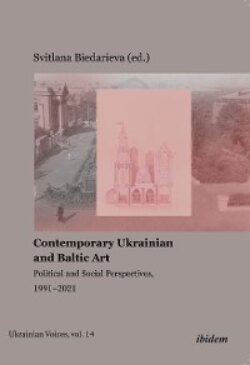Читать книгу Contemporary Ukrainian and Baltic Art - Группа авторов - Страница 17
Bibliography
ОглавлениеAnnus, Epp. (2017). Soviet Postcolonial Studies: A View from the Western Borderlands. London: Routledge.
——— (Ed.). (2020). Coloniality, Nationality, Modernity: A Postcolonial View on Baltic Cultures under Soviet Rule. London: Routledge.
Brown, Kate. (2018). “‘This Part of the World Is Now in the Spotlight’: Katerina Gregos on Curating the Inaugural Riga Biennial Under Putin’s Shadow.” Artnet. 31 May 2018. Available online at https://news.artnet.com/art-world/interview-katerina-gregos-riboca1-1293 896/.
Duester, Emma. (2014). “Artist Mobility and the Baltic Cities: Revealing a Transnational Art World.” Networking Knowledge: Journal of the MeCCSA Postgraduate Network. No. 6 (4). https://doi.org/10.31165/nk.2014.64.321.
Gordon, Avery F. (1997). Ghostly Matters: Haunting and the Sociological Iimagination. Minneapolis, MN: University of Minnesota Press.
———. (2011). “Some Thoughts on Haunting and Futurity.” Borderlands. Special issue “Haunted Futurities.” Vol. 10 (2), 1–21. Available online at http://averygordon.net/files/GordonHauntingFuturity.pdf/.
Gratza, Agnieszka. (2018). “Lens for Looking at Change: Katerina Gregos.” Mousse Magazine. Summer 2018. Available online at http://moussemagazine.it/agnieszka-gratza-katerina-gregos-riboca-2018/.
Gregos, Katerina. (2018). “RIBOCA1 Concept.” In Katerina Gregos and Stijn Maes. (Eds.). Everything Was Forever Until It Was No More. Rīga International Biennial of Contemporary Art. Exhibition catalog (pp. 18-29). Riga: Biennial Foundation.
Hirsch, Marianne. (1997). Family Frames: Photography, Narrative and Postmemory. Cambridge, MA: Harvard University Press.
Hirša, Santa. (2018). “Mākslas kāzu un bēru salons” [Art wedding and funeral salon]. Satori. 11 July 2018. Available online at https://satori.lv/article/maks las-kazu-un-beru-salons/.
———. 2020. “Ziedi plastmasas iepakojumā” [Flowers in plastic packag- ing]. Satori. 6 October 2020. Available online at https://satori.lv/article/ziedi-plastm asas-iepakojuma/.
Honoré, Vincent. (2018). “Introduction: Give up the Ghost.” In Vincent Honoré, Cédric Fauq, and Anya Harrison. (Eds.). Baltic Triennial 13. Give Up the Ghost. Exhibition catalog (pp. 8-11). Vilnius: Contemporary Art Centre; Rome: CURA Books.
Jablonskiene, Lolita. (2010). “All at Sea Together: The Baltic Art Scene of the 1990s.” In Ieva Astahovska. (Ed.). Nineties: Contemporary Art in Latvia (pp. 190-199). Riga: The Latvian Centre for Contemporary Art.
Joyeux-Prunel, Béatrice. (2014). “The Uses and Abuses of Peripheries in Art History.” Artl@s bulletin. Vol. 3, No. 1. “Peripheries.” Spring, 4-7.
Kalnačs, Benedikts. (2016). 20th Century Baltic Drama: Postcolonial Narratives, Decolonial Options. Bielefeld: Aisthesis.
Klimašauskas, Valentinas. (2019). “On Radical Openness.” In Daiga Grantiņa. Latvian Pavilion Saules Suns. 58th International Art Exhibition. La Biennale di Venezia. Exhibition catalog. Riga: Kim? and LCCA.
Koobak, Redi, Tlostanova Madina, and Thapar-Bjorkert, Suruchi. (2021). “Introduction: Uneasy Affinities between the Postcolonial and the Postsocialist.” In Redi Koobak, Madina Tlostanova, and Suruchi Thapar-Bjorkert. (Eds.). Postcolonial and Postsocialist Dialogues: Intersections, Opacities, Challenges in Feminist Theorizing and Practice (pp. 1-10). London: Routledge.
Kukota, Irene. (2018). “Katerina Gregos: We Concentrate on the Baltic Region Because It Is a Terra Incognita.” Russian Art + Culture. 4 June 2018. Available online at https://www.russianartandculture.com/40252-2/.
Lāce, Inga. (2019). “From Science Fiction to Weaving.” In Daiga Grantiņa. Latvian Pavilion Saules Suns. 58th International Art Exhibition. La Biennale di Venezia. Exhibition catalog. Riga: Kim? and LCCA.
Lāce, Inga. (2018). In conversation with Katerina Gregos. “Echo Gone Wrong.” 24 April 2018. Available online at https://echogonewrong.com/inga-lace-conversation-katerina-gregos/.
Makarychev, Andrey, and Segbers, Klaus. (2017). “Introduction: The Baltic Sea Region—Scars, Seams and Stitches.” In Andrey Makarychev and Alexandra Yatsyk. (Eds.). Borders in the Baltic Sea Region. Suturing the Ruptures. London and New York, NY: Palgrave Macmillan.
Miralda, Àngels. (2018). “The Centre and the Story of the Tower.” In Inga Lāce and Àngels Miralda. Outlands. Survival Kit.10.0 (pp.14-15). Exhibition catalog. Riga: Latvian Centre for Contemporary Art.
———. (2019). “Kristina Norman. Bring Back My Fire Gods.” In Šelda Puķīte. (Ed.). Outlands. Survival Kit.10.1 (p. 73). Exhibition catalog. Riga: Latvian Centre for Contemporary Art.
Misiano, Viktor. (2011). In Jarret Gregory and Sarah Valdez. (Eds.). Ostalgia. Exhibition catalog. New York, NY: New Museum New York.
Norman, Kristina, and Elantkowski, Jan. (2018). “Representing a Collective That Has Yet to Be Imagined.” artPortal. 19 November 2018. Available online at https://artportal.hu/magazin/representing-a-collective-that-has-yet-to-be-imagined-kristina-norman/.
Popescu, Carmen. (2014). “At the Periphery of Architectural History—Looking at Eastern Europe.” Artl@s Bulletin. Vol. 3, Issue 1. “Peripheries.” Spring, 8-17.
Rothberg, Michael. (2019). The Implicated Subject: Beyond Victims and Perpetrators. Stanford University Press.
———. (2009). Multidirectional Memory: Remembering the Holocaust in the Age of Decolonization. Stanford University Press.
Rudovska, Maija. (2011). “The Runaway Object of Desire.” Rael Artel. (Ed.). After Socialist Statues (pp.12-17). Exhibition catalog. Riga: PP publications and Kim? And Contemporary Art Centre.
Sinha, Sunita. (2008) “Post-Colonial Women Writers: New Perspectives.” Atlantic Publishers and Distributors.
Smith, Terry. (2017). “The Provincialism Problem: Then and Now.” ART-margins. Vol. 6, Issue 1. February 2017, 6-32.
Soans, Hanno. (2011). “Laughter That Laughs at Itself.” In Your Periphery Is My Center: Lost in Transition (pp.19-25). Tallinn: Tallinna Raamatutrükikoda.
Soomre, Maria-Kristiina, and Talvoja, Kädi. (2012). “Exhibitionary Dynamics of the Soviet era: From Avant-garde to Official Art and Back Again.” In Recuperating the Invisible Past (pp.139-155). Riga: Latvian Centre for Contemporary Art.
Sverdiolas, Arūnas. (2006). “The Sieve and the Honeycomb: Features of Contemporary Lithuanian Cultural Time and Space.” Violeta Kelertas. (Ed.). Baltic Postcolonialism. Rodopi.
Taurens, Jānis. (2021). “Dziedot un dancojot. Divi postkoloniālās kritikas piemēri” [Singing and Dancing. Two Examples of Postcolonial Criticism]. In Arterritory, 1 April 2021. Available online at https://arterritory.com/lv/vizuala_maksla/raksti/25487-dziedot_un_dancojot/.
Tismăneanu, Vladimir. (2010). “The Demise of Leninism and the Future of Liberal Values.” In Costica Bradatan and Serguei Oushakine. (Eds.). Marx’s Shadow: Knowledge, Power, and Intellectuals in Eastern Europe and Russia. Plymouth: Lexington Books.
Tlostanova, Madina. (2017). Postcolonialism and Postsocialism in Fiction and Art: Resistance and Re-existence. London and New York, NY: Palgrave Macmillan.
Untiks, Inga. (2015). “Performing Identities and Convergent Aesthetics in Contemporary Estonian Video Art.” In Claudia Georgi, Brigitte Johanna Glaser. (Eds.). Convergence Culture Reconsidered. Media—Participation—Environments (pp. 65-76). Universitätsverlag Götting-en 2015. https://doi.org/10.25969/mediarep/12012/.
Weeks, Harry. (2010). “Recognizing the Post-Soviet Condition: The Documentary Turn in Contemporary Art in the Baltic States.” Studies in Eastern European Cinema. Vol. 1, No. 1, 57-70.
Yurchak, Alexei. (2006). Everything Was Forever Until It Was No More. Princeton, NJ: Princeton University Press.
